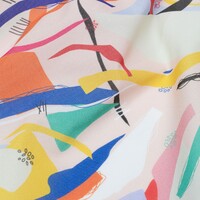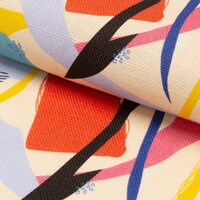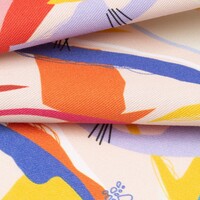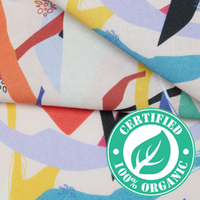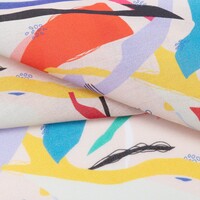Related:
Back to Site Stores ({{popupVm.storeTotalCount}})
Artists ({{popupVm.artistTotalCount}})
Create your own custom sewing fabric with your photos, designs, and text. Browse our range of sewing fabri...
Read MoreShips In 1 - 2 days
Delivery: $12.95
Handmade
You can design custom sewing fabric to use for your next project.
Browse our range of sewing fabrics
Medium weight, soft and non-stretch, matte, sheer and smooth
100% polyester
Medium weight, soft with no stretch, matte and opaque with a smooth surface
84% cotton, 16% poly
Light weight, soft with no stretch, matte and sheer, smooth
100% Pima cotton
Medium weight, non-stretch and soft, opaque and matte
95% cotton 5% linen
Medium weight, soft and matte with no stretch, sheer and smooth
100% cotton
Medium weight, soft with no stretch, matte and opaque
100% cotton
Medium weight, soft with no stretch, matte and coarse, sheer
100% cotton
Certified Organic, Optic White, 100% Cotton Poplin. Super bright colours and deep blacks, strong wash fastness, using reactive ink chemistry.
100% Organic Cotton
Expected Shrinkage = Weft: 2% Warp: 1%
Light weight, soft with no stretch, matte and sheer, smooth. Super bright colors and deep blacks, strong wash fastness, using reactive ink chemistry. Expect shrinkage 1-2% weft, 3-4% warp.
100% Pima cotton
Expected Shrinkage = Weft: 6% Warp: 1%
Care instructions
Wash at 30°C / 86°F, low tumble dry heat, hang to dry, do not wring, low heat iron.




Sewing is one of the oldest textile arts; it is believed that in the Stone age, across Europe and Asia, people sewed the fur and skin of animals using needles made from bone, ivory, and antler with thread made from various animal parts - including veins. Modern day sewing is much less gorey, using threads of various colors and metal needles to stitch together two (or more) pieces of fabric. For thousands of years, sewing was all done by hand, but the 19th century saw the invention of the sewing machine, and now all sorts of people stitch by hand or machine from textile artists, tailors and dressmakers to hobbyists all around the globe. You can sew with any number of fabrics, but cottons and polycottons remain the most popular, with characteristics and weights that lend themselves to the fine art.
All sewing fabric is printed digitally, using either a pigment printing or dye sublimation method. It can be sent as it comes from the printer, or cut on the line with the white borders removed. Depending on the type of sewing project you are undertaking, you may want to have your sewing fabric hemmed; one of our expert seamstresses will either hem your sewing fabric with an overlock hem or with a folded hem using a straight stitch. You can have your custom sewing fabric hemmed with either black or white cotton - no veins, we promise.
In regards to the Pima Lawn Cotton and Cotton Linen, there can be occasional very small white dots where pieces of cotton fluff are removed revealing unprinted white base material. Please note that this is normal and cannot be avoided but won't affect the strong colors and detailed nature of your print.
All of our fabrics are printed at 200dpi. This works for us as it combines a great quality as well as a good file weight. In order to avoid resizing and interpolation, we recommend that you scale your image to 100% at 200dpi. Our design interface works with a traffic light system that acts as a quality marker for your designs. This will show you whether the resolution is too low for printing. When you re-upload your design with a highest resolution, the traffic lights will change color, showing you're good to go. A message will pop up alongside the traffic lights to let you know if the resolution is too low or if you have a good quality image.
Your uploaded design will automatically be scaled to fit the size of fabric you've chosen. You can change the dimensions of your fabric by amending the measurements on the ‘Product Options’ tab, under ‘Print Size’. To see how this fits with the dimensions of your image/design, you can refer to the ‘Images & Text Tools’ tab under 'Quality Information'. Here, you will be able to edit the dimensions of the image.
We always recommend using an RGB color space when you upload your images. More specifically, we suggest using the sRGB image profile, to achieve best color results. This will need to be done in your editing software; choose RGB as the working space, and assign the image profile as sRGB (full name sRGB IEC61966-2.1)
There is no length limit for most of our fabrics. Our preview design window is set up to displaying a maximum of 10m (32.8 ft) to help you visualize the print, but that doesn't mean this is the print limit. If you'd like to order more, you can increase the quantity (x2 for 20m or x4 for 40m for example) and order as much as you'd like. Larger volumes will receive an automatic discount too. While the fabric length is nothing to worry about, each individual fabric will have a maximum width side: These can be found on the fabric's page information or in the design interface.
Yes, that will help you when it comes to cutting or framing your printed fabric. We recommend always adding a little extra space for borders into your purchased fabric size. When we print your materials, or send out fabric samples, we typically trim squarely around the fabric, leaving approximately 5mm white space. Cutting neatly on the line has an additional fee.
Crocking is the term used to describe fading along the creases in a fabric. It typically can occur after constant washing or heavy use of digitally printed natural fabrics. Crocking can be minimized by hand washing your fabrics at a cooler temperature, rather than machine washing. If you want to make sure there's no chance of crocking, we'd suggest you use a poly fabric.
Yes, our organic fabrics don't have an additional coating like non-organic fabrics have, which means it absorbs the inks deep into its fiber and reducing the color strength slightly (this can be approximately -40%). If you would like a bolder, more vibrant color for your fabric, we would suggest using a non-organic fabric.
Unfortunately not; all of our fabrics have been tested meticulously to ensure we know exactly how to get the best results, and our facilities cater perfectly to them. If you are set on a fabric we don't offer, we can offer custom printed sublimation paper to order which will allow you to heat press your designs onto your own fabrics.
If your design is simple and less intricate, a JPEG will be absolutely fine. However, if you have created a design with multi-colored detailing, we would recommend saving your design in a TIFF format.
Similar to other fabric printing processes, shrinkage can occur. The amount of shrinkage will depend on the fabric, but as a general rule of thumb, please allow for 2-8% shrinkage when working out your measurements. Shrinkage is not an exact science, and the amount of shrinkage will vary from print run to print run. We'd always suggest order a little more than you need for your project.
Many of the fabrics we offer are semi-transparent, so printing on both sides of the fabric is not a service we offer.
At the moment, all of our fabric labels are printed on satin fabric. For now, we believe this is the best choice, but will potentially introduce other options in the future. All labels are cut to the same label format. If you would like to choose a different fabric and format for your labels, you could always order a sheet of the fabric of your choice to create labels yourself.
Our fabrics are printed with water-based inks as environmental consciousness is always front of our minds. Water-based inks include no chemicals or solvents, and our printing process uses heat to fix colors and patterns into place to avoid excess or contaminated water returning into the water system (this is something that can occur through steaming). All printing, fulfilment and production is done in our one facility, and rather than rolling the fabrics or sending them in a tube, you will receive your material folded up. This amounts to 150 tubes saved a week, as well as much more space on the delivery van for more orders. (For delicate fabrics we ensure to package appropriately).
Although very rare, there could be a slight color difference from one print run to another. This is a normal part of the printing process, however we are always working to improve our color profiles. It is unlikely that the difference in print runs will be hugely different (for example, it's unlikely your orange is suddenly going to be red). The likelihood of color variations can be intensified fabric to fabric due to materials having different grains and textures; natural fabrics typically have more muted color tones, while poly alternatives have a bolder hue. This is because the construction of the material is different, and the printing method has to be altered slightly for more delicate, natural textiles.
Our full cut & sew service at Bags of Love can be used to your full advantage. We even offer hemming for your fabrics at a small additional cost. Our hems are created with a one or two cold hem that typically uses around 5 to 20mm of fabric (depending on the thickness of your chosen material). Please bare this in mind when you are ordering your printed fabric with hems: If you would like your finished piece to be 40" x 40", change your dimensions to 41" instead to allow space for your hems (you will also need to include additional for potential shrinkage). The thicker the fabric, the bigger the hem will be. Your printed fabric will be hemmed with either Black or White thread. If you are ordering a lightly woven material or a printed silk, you will find that one hem will be straight, while the other slightly rippled. The hemming material allowances are as follows and you need to make your print bigger to accommodate the hem:
For further information about our fabrics see our FAQs.
Please note: As everything we provide is handmade to order, you may find a slight variance in the sizes.


